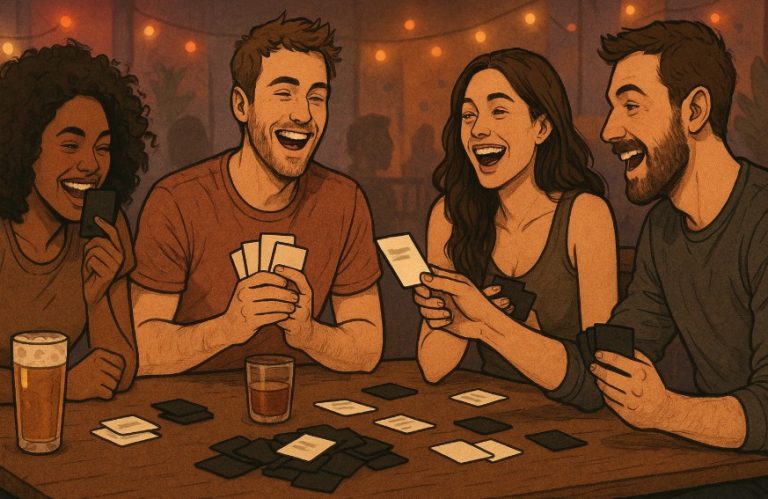The Higher or Lower card game, often referred to as Play Your Cards Right, is a classic and engaging card game that has long been a staple at British fetes, pubs, and promotional events.
Known for its simplicity and fun factor, it provides endless entertainment for players of all ages and skill levels. Whether used to raise funds at local fairs or boost engagement at exhibitions and club nights, this game continues to captivate participants with its mix of chance, excitement, and suspense.
This comprehensive guide explores everything there is to know about the higher or lower card game—from how to set it up and play, to tips and strategies that improve the odds of winning.
What Is the Higher or Lower Card Game?
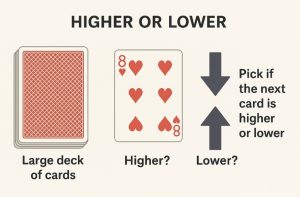
The higher or lower card game, also known by its television counterpart name “Play Your Cards Right,” is a game of prediction that uses a deck of standard or oversized playing cards.
The core mechanic of the game is simple: players must guess whether the next card revealed will have a higher or lower value than the previous one.
It’s a game primarily based on luck, though strategic guessing and understanding of card probabilities can play a small role in improving success.
This card game is widely used in the UK for public events and entertainment due to its ease of setup and broad audience appeal. It’s a go-to choice for game nights, pub events, exhibitions, community fetes, and school fundraisers.
The simplicity of the rules means it can be quickly learned, making it ideal for engaging large groups of participants without long explanations.
How Do You Set Up the Higher or Lower Card Game?
Setting up the game is relatively easy, making it ideal for both casual events and professional promotional use. A basic version of the game requires only a deck of cards and a table, but for larger events, a more structured setup can enhance the experience.
A typical event-based setup includes:
- A freestanding game board, usually made of MDF, approximately 45cm wide by 61cm high
- Large-format playing cards (often 6-inch size) for visibility
- Card ledges on the board to display the current and next cards
- Advertising materials such as A3 posters and rule signage
- A guideline sheet for the facilitator to follow
This setup allows the game to be presented in a more formal and engaging manner, especially in public spaces or during corporate events. Some boards are painted black with “Higher or Lower” text in yellow for branding and visibility.
What Are the Rules of the Higher or Lower Card Game?
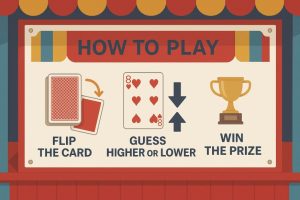
The rules are straightforward and easy to communicate, which is a key reason the game works so well in group or public settings. The gameplay typically follows this flow:
- The facilitator shuffles the deck and places the first card face-up
- The player makes a prediction about whether the next card will be higher or lower in value
- The next card is drawn and revealed
- If the prediction is correct, the game continues with the new card
- If the player is wrong, the game ends for that round
Standard rule conventions include:
- Aces are considered the lowest value
- Kings are the highest value
- In most variations, if the next card is of equal value to the previous one, the guess is counted as incorrect
- Games can include between 5 to 10 cards per round, depending on how challenging the organiser wants it to be
This simplicity allows organisers to explain the rules quickly, enabling rapid turnover and keeping crowds entertained.
How Do You Play the Higher or Lower Card Game Step-by-Step?
The game can be played one-on-one or with a group of participants taking turns. Here’s a clear step-by-step breakdown of how it typically works:
- Shuffle the deck thoroughly to ensure randomness
- Place one card face-up on the board or table
- Ask the player to predict if the next card will be higher or lower in value
- Reveal the next card and compare it to the previous one
- If the guess is correct, the player continues
- If the guess is incorrect or a tie occurs (depending on house rules), the player loses
- Repeat this sequence for the chosen number of cards (usually 5 to 7)
This flow makes the game suitable for fast play, helping to keep lines moving at busy events or maintain energy during casual game nights.
What Are the Best Strategies to Win the Higher or Lower Card Game?
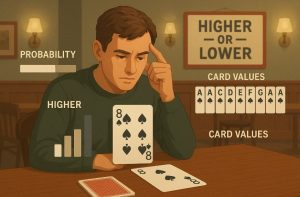
Although the higher or lower card game is primarily based on chance, especially in single-round formats with a shuffled deck, experienced players and regular participants at events have developed approaches that can slightly increase the odds of success.
These strategies are not guaranteed to work every time, but they can provide a helpful edge, particularly when the game is played with rules that allow deck tracking or when played over multiple rounds.
Understanding Card Value Probabilities
One of the key strategies revolves around understanding card distribution in a standard 52-card deck. Each card value from Ace to King appears exactly four times (once per suit), meaning certain predictions become more or less likely depending on what cards have already been revealed.
For example:
- If a 2 is revealed, it is statistically safer to guess that the next card will be higher.
- If a King appears, the next card is almost always lower, since no card ranks higher.
- Cards in the middle range, such as 7, 8, and 9, are more unpredictable. These should be approached cautiously or treated as high-risk moves.
In live games that use the same deck across multiple rounds, players who pay attention to what cards have already appeared have an advantage.
This is often referred to as deck tracking or card memory. For example, if three Kings have already been played, the likelihood of drawing another is greatly reduced.
Position-Based Guessing
Another commonly used technique is to take the position in the sequence into account. In most formats, players are required to guess five to seven cards in a row to win.
Some prefer to adopt a conservative approach in the early stages and become more aggressive later, while others do the opposite.
Early conservative play might involve:
- Playing statistically obvious calls (e.g. guessing higher after a 3, lower after a Queen)
- Avoiding risky mid-value guesses unless absolutely necessary
In contrast, a risk-forward approach would involve taking bold guesses early, hoping to get a long streak, and withdrawing or restarting the round quickly if it fails.
Adapting to Rule Variations
Event organisers sometimes introduce house rules such as “no loss on ties” or allowing one mistake per round. These should influence how a player approaches the game:
- With no loss on ties, the player has a safety buffer for values such as 7 or 8, making those guesses more viable.
- If one mistake is allowed, players might take slightly riskier bets earlier in the sequence.
Understanding and adapting to these rule tweaks is a skill in itself and often separates casual players from more strategic participants at recurring events.
Observing Past Rounds
In fundraising environments or pub events where the same deck is used across multiple participants without shuffling each time, observant players can gain a slight advantage by remembering which high or low cards have already appeared.
For instance, if most of the 10s, Jacks, and Queens have been played, the deck is statistically leaning toward lower-value cards.
Psychological Confidence
Although not mathematical, maintaining confidence and rhythm can also affect performance. Second-guessing or hesitating may lead players to ignore a statistically safer call. Many experienced players suggest sticking with instinctive decisions, especially when faced with borderline card values.
These strategies, though not foolproof, can contribute to improved performance over time. They make the game more engaging and competitive, especially in repeat-play environments where observation and memory play larger roles.
Where Can You Use the Higher or Lower Card Game for Events or Promotions?
The higher or lower card game is remarkably flexible, which is why it has become such a popular fixture at public events, corporate functions, and marketing activations.
Its easy-to-understand mechanics, minimal setup costs, and broad appeal make it an ideal choice for organisers seeking an interactive game that can be scaled up or down depending on the venue.
Community and Fundraising Events
One of the most common uses for the game is at fetes, school fairs, and charity fundraisers. It works especially well as a side stall attraction, drawing crowds due to the simplicity of the rules and the immediate opportunity to win a prize.
In this context, organisers typically charge a small entry fee to play and offer modest prizes to winners. Because rounds are quick and participation is high, it becomes a cost-effective way to raise funds.
Benefits in these settings include:
- Low equipment cost (deck of cards, game board, signage)
- Easy explanation of rules to both children and adults
- High engagement without requiring supervision from skilled personnel
Bars, Pubs, and Social Clubs
In bars and pubs, especially in the UK, the higher or lower game is often incorporated into quiz nights, themed events, and interactive entertainment evenings.
Hosts typically use large cards on a display board and invite audience members to participate between trivia rounds or as a standalone mini-game.
It serves to:
- Break up quiz segments and maintain crowd energy
- Reward regular patrons with drink vouchers or bar credits
- Create a sense of friendly competition
Bar owners sometimes sponsor the game as a promotional activity, tying it into drink promotions or loyalty programs.
Trade Shows and Exhibitions
The game is also frequently adapted for trade shows and product exhibitions, where brands and exhibitors use it as a way to attract attention to their stands and interact with potential customers.
In this format, branded game boards and cards are used, and the game becomes a fun incentive for passersby to engage.
A typical implementation might involve:
- Allowing visitors to play in exchange for their contact details
- Offering branded giveaways for winners
- Hosting short competitions throughout the day to boost engagement
Because the game can be played quickly, it suits the fast-paced, high-traffic environment of commercial exhibitions.
Corporate Events and Team-Building Activities
Many companies now use the game as part of their internal team-building days or holiday parties, where the goal is to encourage interaction and collaboration among employees. It may be played in teams, or as part of a larger game show-style event.
Organisers may customise the experience by:
- Creating a themed version relevant to the company’s culture or values
- Including trivia or challenges between card reveals
- Offering corporate prizes for successful teams
It’s particularly effective as an icebreaker or mid-day energiser during multi-hour events or training days.
Private Parties and Celebrations
For smaller-scale applications, such as birthday parties, family gatherings, or themed celebrations, the higher or lower card game can provide a light, fun activity that involves everyone. It requires no prior card-playing experience, making it ideal for groups with diverse ages and backgrounds.
Event planners often include it as a:
- Mini game station during garden parties or receptions
- Competitive party game with light-hearted forfeits or rewards
- Child-friendly entertainment during mixed-age family events
In these cases, the simplicity of setup allows it to be implemented with minimal preparation but high entertainment value.
Whether used in public, professional, or personal settings, the higher or lower card game consistently proves to be one of the most adaptable and cost-efficient entertainment formats available.
It not only attracts participation but also encourages social interaction, making it ideal for event organisers looking to create memorable experiences with minimal fuss.
Can the Higher or Lower Card Game Be Played Online?
The game has found a new audience online, where digital platforms offer both paid and free versions of the experience. These are particularly popular among casual gamers and users looking for quick, low-commitment entertainment.
Table: Differences Between Physical and Online Versions
| Feature | Physical Version | Online Version |
| Setup | Requires cards, board, and space | No physical items needed |
| Interaction | In-person social engagement | Digital only, often solo |
| Game Speed | Slower, more paced | Fast-paced clicks or taps |
| Visual Appeal | Can be customised with props | Animated graphics and sound effects |
| Accessibility | Requires physical presence | Available anywhere with internet access |
Online platforms often include features like scoreboards, multiplayer modes, or themed card decks to maintain player interest. However, they lack the tactile and social elements that make the in-person version ideal for group events.
How Does Higher or Lower Compare to Other Card Games?
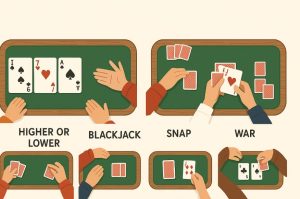
When compared with other classic card games commonly played in the UK, higher or lower offers a unique blend of simplicity and crowd appeal. It differs notably in the skill-to-chance ratio and the typical context in which it is played.
For example, games like Blackjack require calculation and decision-making, while Snap relies heavily on reaction speed. Higher or lower sits in between, offering a fun guessing experience without demanding complex strategies.
This makes it one of the most inclusive card games, as it can be played effectively without prior experience, reading ability, or detailed knowledge of card rules.
What Are Some Common Variations of the Higher or Lower Game?
To keep the game fresh for repeat players or to align with specific event goals, several variations can be introduced. These allow organisers to increase difficulty, enhance engagement, or add thematic elements.
Some effective variations include:
- Joker Wild Cards: Introducing joker cards that allow an automatic pass to the next round
- Timed Rounds: Players must make their prediction within a set time limit
- Trivia Intervals: Between each card, the player must answer a trivia question to continue
- Themed Decks: Using customised card designs for holidays, company branding, or pop culture themes
These modifications maintain the core structure of the game but add layers of complexity or excitement, making them ideal for corporate promotions or high-attendance events.
Why Is Higher or Lower Ideal for All Ages?

One of the strongest appeals of the higher or lower card game is its universal accessibility. It does not rely on literacy, advanced motor skills, or deep cognitive processing, making it ideal for mixed-age groups.
The benefits for various age groups include:
- Young children can grasp the basic high/low concept easily and feel involved
- Teens find it engaging and competitive without requiring much effort
- Adults appreciate the social and fun aspect, especially in casual settings like pubs or fundraisers
- Seniors enjoy the low physical demand and nostalgic feel of traditional card games
Whether played casually at home or professionally at an event, this card game remains one of the most inclusive and flexible entertainment options available.
Conclusion
The higher or lower card game remains a timeless favourite across the UK due to its simplicity, versatility, and wide appeal. Whether used at community fetes, in pubs, or as part of promotional events, it offers fun and excitement for all age groups.
With minimal setup and endless customisation options, it’s an ideal addition to any gathering. By understanding the rules and employing a few smart strategies, players can enhance their chances while enjoying this engaging game of chance.
FAQs About Higher or Lower Card Game
What card values are used in the higher or lower game?
All cards in a standard 52-card deck are used, with Aces typically counted as low and Kings as high. No suits are considered—only values matter.
Can children play the higher or lower card game?
Yes, the game is child-friendly and easy to understand. It’s suitable for ages 6 and above with proper supervision in event settings.
How many cards do players need to guess correctly to win?
This depends on the organiser. Most events use between 5 to 7 cards in a sequence. All must be guessed correctly for the player to win.
Is the higher or lower game legal for fundraising?
Yes, it’s often used in raffles and charity events in the UK. Just ensure you’re compliant with local charity laws or fundraising regulations.
How can the game be branded for corporate use?
Boards can include logos, colours, or themed designs. Customised promotional items or banners can also be included to enhance visibility.
What happens in the event of a tie between cards?
In many formats, a tie results in a loss for the player. However, organisers may implement a “no loss on tie” rule depending on their preferences.
Can this game be played solo or in teams?
Yes, it can be played solo for individual prizes or in teams where each member takes turns guessing. It works well either way.


